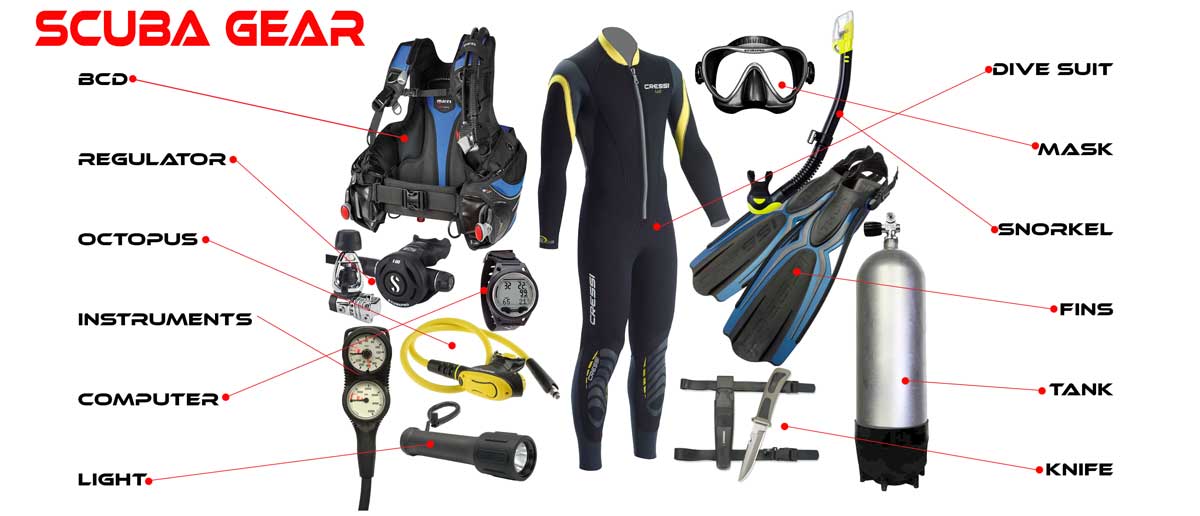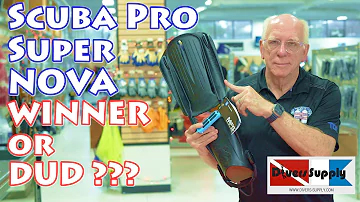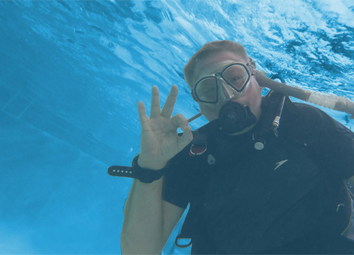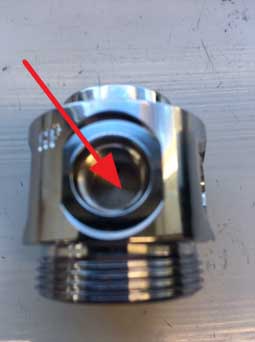We use cookies to enhance your experience on our website. By clicking “I Agree,” you consent to our use of cookies in accordance with our Privacy Policy. If you choose not to allow cookies on our website, some of the website’s functions may not be available to you. Learn more.
Scuba Gear
In order to explore the underwater world a diver has to adapt to the underwater environment. The human body is designed to function on land, because the underwater environment is very different from our own , Scuba gear is required to enable us to see, breath, move, and stay warm underwater. It is not required that you purchase Scuba Gear you can always rent it from a reputable Scuba Store. However, we recommend that you learn to dive with your own scuba equipment. Dive Equipment often performs differently due to design variations, fit & adjustment. Owning your own Scuba Gear allows you to personalize your gear for proper fit and adjustment and allows you to adapt and be familiar with your new equipment. It’s a well-known fact that the new diver becomes more efficient and enjoys scuba diving more when they learn to dive with their own equipment.

Scuba Mask 
Because the human eye is made for seeing clearly in air, a diver must create an air space between his eyes and the water to be able to see. A dive mask enables the diver to see and it also protects his eyes and a good portion of his face against the cold, water impurities and salt. Most masks today are made of silicone while a few are still made with rubber. Certain masks come with a purge valve, others can be fitted with corrective lenses. All Scuba mask encompass the nose to allow you to equalize the pressure in your mask and sinuses. Low-volume masks are easier to clear when flooded they are preferred by most divers. The air inside the mask is warmer than the surrounding water which causes condensation or fog to form on the inside of the glass. To eliminate this fogging divers use a non-irritating solution refered to as De-fog to ensure clear vision throughout the dive.
 Scuba Snorkel
Scuba Snorkel
The snorkel is required to breath air at the surface without emerging the head from the water. This enables a diver to swim at the surface without losing sight of his underwater surroundings at the samme time conserving air from his tank. Many snorkels are equipped with purges that keep the snorkel partially or totally dry when submerged making them easier to clear. Snorkels are rarley longer than 12 inches because the pressure exerted below that depth makes it nearly impossible for a person to fill his lungs.
 Scuba Fins
Scuba Fins
Water is 800 times denser than air and thus offers much more resistance to a diver trying to move forward. Since the diver is esentially floating in mid-water without solid footing, the diver needs a way to propel him through the water. Fins offer a flat and solid surface that enables the diver to move effectively. Fins come in many designs with vaying surface areas. They are made of plastic , rubber or various fibers. Larger blades offer more power but demand more energy in return and shorter fins are more maneuverable.
 Scuba Regulator
Scuba Regulator
The regulator is a vital link in the SCUBA life support system! A diver can only breath air at a pressure equal to ambient pressure, that is, the pressure which surrounds him. A diving regulator is used to release the compressed air in the tank to the diver at ambient pressure and at any depth. Most professionals recommend that you purchase the highest quality regulator that fits you budget. With that in mind, every regulator that we sell will perform effectively and you can depend on all of them within their design limitations.
SCUBA regulators are classified as demand regulators. Meaning each time you breath, you will receive air (on demand). Some regulators do this more efficiently that others, but all regulators will deliver air efficiently. It is highly recommended that you have your regulator, octopus, buoyancy compensator and tank inspected and serviced at least once a year by an authorized service center. Divers Supply’s award winning service center is the architect of the double check service system. Meaning, your equipment is serviced by one technician and inspected by a second technician before it is released to the customer. Many manufacturers provide a lifetime warranty program on their regulators. This normally means they will provide most parts at no cost if you have your regulator serviced each year within 30 days of the purchased anniversary date.
 Scuba Safe Second (Octopus)
Scuba Safe Second (Octopus)
The octopus regulator is required for all divers. It is an emergency air supply for your dive partner, as their octopus is for you. Most octopus regulators are adequate, as they are all dependable. We recommend that you use an octopus holder to position the octopus for quick access and to keep it from dragging the bottom, which could damage it.
Spare Air or Pony Bottle: Although not required, consider the Spare Air or Pony Bottle as a backup air system. Both of these unique systems provide you with a backup air source, giving you the capability of self rescue in the event of a regulator malfunction or out of air emergency.
 Scuba Buoyancy Control Device (BCD)
Scuba Buoyancy Control Device (BCD)
The buoyancy compensator or buoyancy control device (BCD), serves a double purpose. It permits the diver to adjust his buoyancy as it constantly changes during his descent and ascent. Buoyancy must be kept as neutral as possible throughout the dive. This will enable the diver to move more easily, use less air and keep safe from the sea bottom. It is also a potential life saver which allows the diver to ascend easily in a problematic situation and to rest comfortably at the surface. All Scuba BCDs are designed to hold the Tank or scuba cylinder securely to the diver. The BCD has various valves that are easily accessible to the diver for fast air entry and also to vent the air for the diver to control the buoyancy. An overpressurization valve to vent excess air quickly and automatically is on all BCDs to keep the bladder from rupturing. The are a variety of designs with different pockets and D-rings used for carrying or clipping on various equipment including pocket weights in the case of a weight integrated BCD.
There are four basic types of BC’s
(1) Horse Collar: Not recommended for sport diving.
(2) Jacket Style (Air under the arms – Floats you high when at the surface)
(3) Back Buoyancy (Very comfortable and very stream lined)
(4) Hybrid (Combination of both the back buoyancy and the jacket style BC).
Main points of consideration:
- Fits properly
- Adequate lift (buoyancy) for the dive environment
- Weight integrated system
- D-rings and other attachment points (pockets are nice but often D-rings are more efficient)
 Scuba Gauges
Scuba Gauges
At a minimum your instruments must provide you with information about your dive depth, dive time, the air pressure remaining in your tank, and a compass to monitor your underwater direction.
You may purchase a dive watch, depth gauge, pressure gauge and compass individually or in a console. However, a dive computer is your best choice. An air-integrated computer replaces the dive watch, depth gauge, pressure gauge, dive tables and provides you vital real time information that would not be available with other instruments are gauges. The compute provides this information instantly and automatically calculates all changes and deviations than you may make during your dive.
We recommend that you purchase a computer because it provides you much more information, making your dive much safer. In fact, if your budget permits, we recommend that you purchase an air-integrated computer.
 Scuba Dive Computer
Scuba Dive Computer
The dive computer practically eliminates the need for a watch or dive tables. They are becomming more popular with divers since there arrival in the early 80s. The dive computer keeps track of the maximum depth, present depth, dive time, resurfacing speed, the number of dives made, dive parameters, surface time between dives, amount of nitrogen in a divers body, delay time to be respected before flying and more. Dive computers have advanced tremendously and come in a variety of configurations from watches to consoles most modern computers allow computers to be set for air or oxygen enriched air diving.
 Scuba Cylinders (Tanks)
Scuba Cylinders (Tanks)
A diver on scuba needs a supply of compressed air in order to breath underwater. Scuba cylinders (tanks) come in several capacities ranging from 6 to 130 cubic feet (cubic feet represent the gas capacity of the tank and 80 cubic tanks are the most popular size). Scuba tanks come in two basic metals: Aluminum and Steel
Steel tanks cost more and are more durable and more negative buoyant in the water than aluminum tanks. This negative buoyancy is usually an advantage as it enables the diver to wear less lead weight when using steel tanks.
Aluminum tanks cost less and are less durable but are more positive buoyant in the water which usually requires the diver to wear more lead weight. Pre 1990 aluminum tanks have a higher inspection failure rate and it should be noted that some dive centers won’t fill or service pre 1990 aluminum cylinders.
• All scuba cylinders must undergo inspection and be re-certified as listed below:
1. Annual inspection (VIP & VIP Plus Inspection)
2. Every 5 years (Hydrostatic Inspection)
Scuba Breathing Gases
There are two basic types of breathing gases available to the sport scuba divers.
1. Pure Air – Air is filtered then pumped under pressure into the breathing cylinder (Scuba Tank). Always purchase your air fills from a Certified Pure Air Station.
2. Nitrox – Air is blended with oxygen and filtered then pumped under pressure in to the breathing cylinder (Scuba Tank). In many ways this is a safer gas to breath and it will increase you bottom time. Nitrox comes in several oxygen blends and requires specialty training and certification before use. Always purchase your nitrox fills from an authorized nitrox blender and always analyze each fill yourself.
 Scuba Diving Suits
Scuba Diving Suits
There are a wide variety of suits available for Scuba diving mainly because divers dive in different water temperatures. Because your body cools 25 times faster in water than air it is essential to get a suit to keep you warm. When choosing a Scuba diving suit you would look for a suit in the thickness needed to protect you from the cold.
Wetsuits
Wetsuits are the most common it works on the principle that your body warms and traps the water that enters the suit. A suit that fits snug is highly desirable to prevent the water from easily entering and exiting the suit, causing heat loss. The comfort of a suit is very important and you should consider the suits with high stretch materials. They cost more but provide a much higher level of comfort. The thickness and fit of the suit is the most important consideration. For proper fit ask our staff or see the catalog size chart.
Dry Suits
The dry suit allows the diver to dive in colder water for longer periods and becomes a viable option for the more active divers. A diver protects himself from losing excessive heat when diving in cold water by wearing an insulated thermal suit. The suit reduces or totaly eliminates direct contact of the skin with the water. The length of time this protection will last depends on different factors, including the type and fit of the suit, the depth of the dive and the water temperature. The suit will also provide protection against minor injuries, sunburn and scratches that can occur on contact with the sea bottom.
 Weights
Weights
A wet or drysuit increases a diver's positive buoyancy making it difficult to descend to the bottom. To compensate for this, the diver wears a weight belt, a weight harness or weight pockets in his BCD. The weight belt is made of strong woven nylon and has a one hand release buckle that is quick and easy to snap on or off when required. Lead bullets or other shapes are tightly threaded into the belt or pockets of the belt. The weight should neutralizes the divers buoyancy and should be adjusted depending on equipment and density of the individual diver. Weights come in different shaps sizes and material the most common today is shot weight that fits into a pocket belt or weight integrated BCD pocket.
 Knife or line cutter
Knife or line cutter
A knife has many uses, but the main function for the diver is to cut monofilament or other types of line that you or your partner may become entangled in. Think of your knife or line cutter as an insurance policy, one that you hope you never use, but it’s there if you need it. We recommend any knife or dive tool with a line cutter and a sharp blade.
Underwater Lights
There are 3 broad categories of Underwater Lights (1) Primary Light, which is required when diving at night or in areas of low visibility such as deep, caverns, caves and wrecks dives. (2) Secondary Light is required on all dives (day or night). It is also carried as a backup to the primary light. This is a small light, which may be used for illumination or as a signaling device. (3) Strobe or Chemical lights, are used primarily to signal or mark a person, item or location.
Dive Bag
A dive bag is a must to secure, protect and transport your gear.
Dive Flag
The dive flag is required by law and when deployed it indicates that a diver is below. This signals all boats to standoff a minimum of 100 feet from the dive flag.
The minimum size for any divers-down flag displayed on a buoy or float towed by the diver is 12 inches by 12 inches. The minimum size for any divers-down flag displayed from a vessel or structure is 20 inches by 24 inches.
Other Accessories to consider:
- See-Me-Float or Surface Marker
- Lift Bag
- Marker Buoy
- Finger Reel (Dive Reel)
- Mirror
- Whistle
- Slate
- Save-A-Dive Kit
- Spare O-Ring Kit
- Mask Defog
- Small First Aid Kit
- Dry Boxes
Ready to Shop for Scuba Gear or have additional questions? Call or chat with one of our operators, we are here to help and we are all Scuba Certified Divers here at Divers-Supply.com.
-
29 DecRead more »
The Hog "Zenith Regulator" awarded Scuba Lab Testers Choice
Balanced-diaphragm first stage; two hp, five lp ports; 360-degree swiveling turret Available in Yoke or Din configurations.
-
29 DecRead more »
Mares Quad has Jumbo size information











